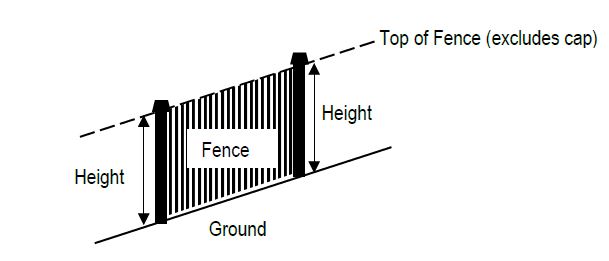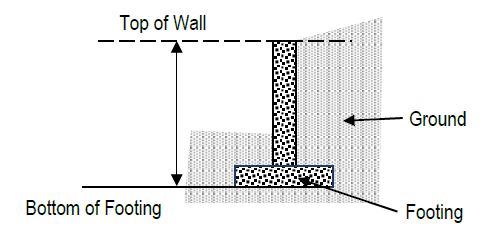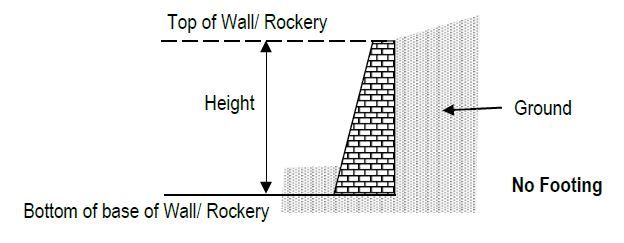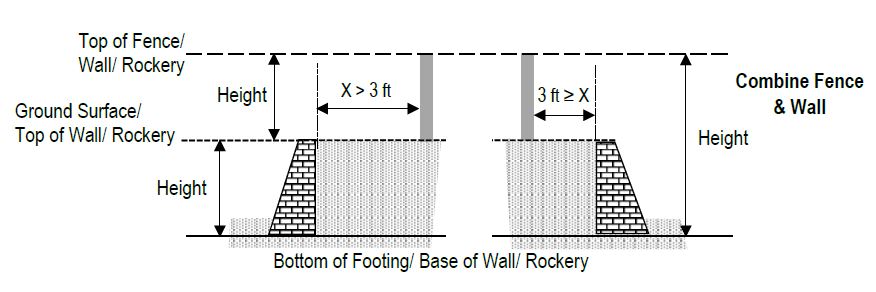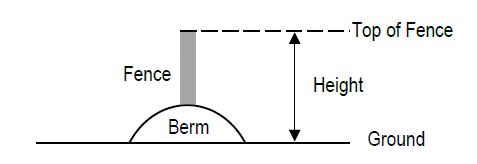Division 4. Use-Specific Development Standards
Chapter 21.40
CITY-WIDE USES
Sections:
21.40.010 Fences and retaining walls.
21.40.020 Storage area for the collection of recyclables and solid waste.
21.40.050 Drive-through standards.
21.40.060 Sight distance requirements.
21.40.070 Adaptive reuse of nonresidential buildings.
21.40.010 Fences and retaining walls.
(1) General Provisions.
(a) Fences, rockeries, and retaining walls are permitted in all zones subject to the provisions in this section.
(b) The construction of fences, rockeries, and retaining walls require a building permit unless exempt pursuant to Chapter 21.62 WMC, Building Codes.
(c) Fences, rockeries, and retaining walls shall be located entirely inside the property lines of a lot, unless both property owners agree the structure may be placed on a common property line. Property owners are responsible for confirming all fences, rockeries, and retaining walls are placed inside the property lines of their property.
(d) Lighting devices placed on top of a fence, rockery, or retaining wall are not subject to the height limitations prescribed in subsections (2)(a) through (d) of this section.
(e) Fence post caps may exceed the height limits set forth in subsections (2)(a) through (d) of this section by up to six inches.
(f) Trellises and similar structures incorporated into a fence and used to support climbing plants, and gate entry overhead structures are exempt from the height limits set forth in subsections (2)(a) through (d) of this section, provided they do not exceed a height of 15 feet from the finished grade directly below.
(2) Fences, rockeries, and retaining walls shall comply with the following maximum height requirements:
(a) Within a residential zone, fences, rockeries, retaining walls, and combination fences, rockeries, and retaining walls located within property line setback areas shall not exceed six feet in height;
(b) Within nonresidential zones, excluding the NB zone, fences, rockeries, retaining walls, and combination fences, rockeries, and retaining walls located within property line setback areas shall not exceed eight feet in height;
(c) Within the NB zone, fences, rockeries, retaining walls, and combination fences, rockeries, and retaining walls located within property line setback areas shall not exceed six feet in height;
(d) If no property line setback applies, or a property line setback is reduced to less than five feet, the maximum heights set forth in subsections (2)(a), (b) and (c) of this section shall apply to fences, rockeries, retaining walls, and combination fences, rockeries, and retaining walls located five feet or less from a property line; and
(e) Fences, rockeries, and retaining walls located outside of the areas prescribed in subsections (2)(a) through (d) of this section are subject to the height requirements applicable to other buildings and structures on the lot in which the fence, rockery or retaining wall is located.
(3) The height of fences, retaining walls, and combination fences and retaining walls shall be measured as follows:
(a) Fences: height is measured from the ground surface directly underneath the fence to the top of the fence including posts as illustrated in Figure 21.40.010A;
(b) Retaining walls with footings: height is measured from the bottom side of the footing to the top of the wall as illustrated in Figure 21.40.010B;
(c) Rockeries and block style retaining walls without footings: height is measured from the bottom side of the base to the top of the wall/rockery as illustrated in Figure 21.40.010C;
(d) Fences, retaining walls, and rockeries shall have their height combined for purposes of measuring height if the horizontal separation between the closest points of the structures is three feet or less as illustrated in Figure 21.40.010D, except those fences, retaining walls and/or rockeries separated by a property line shall not have the fence, retaining wall, or rockery on the other lot included in measuring height;
(e) The placement of a guard rail on top of a retaining wall or rockery may exceed the maximum height for a retaining wall or rockery by up to four feet, provided the solid component parts of the guard rail are evenly distributed and cover no more than 50 percent of the total surface area of the side elevation of the guard rail; and
(f) No person may place a fence on a berm, unless the combined height of the berm plus the fence does not exceed the maximums set forth in subsection (2) of this section as illustrated in Figure 21.40.010E.
(4) Special Provisions for Fences.
(a) Electric fence is permitted in all zones subject to the following:
(i) Within the R-4, R-6, R-8, R-12, R-18, R-24, and R-48 zones, additional fencing or barriers shall be constructed to prevent inadvertent contact from adjoining properties from which the electric fence is located;
(ii) The electric flow is limited to either an interrupted flow of current at intervals of about one second on and two seconds off that does not exceed 2,000 volts at 17 milliamps, or a continuous flow of current that does not exceed 1,500 volts at seven milliamps;
(iii) Warning signs notifying of the electric fence shall be posted at intervals not more than 50 feet with the surface area of each sign not exceeding 288 square inches (two feet by one foot).
(b) Barbed or razor-wire fence is permitted only in the R-1 and Industrial zones, except fences erected in other zones designed to protect sewer, water and other critical public infrastructure may include barbed wire placed above the fence provided the barbed wire does not exceed 18 inches in height.
(c) The Director may require additional screening and design elements to be incorporated into fences, retaining walls, and rockeries to substantially reduce visual impacts from public streets. Such additional elements may include, but are not limited to:
(i) Decorative block walls, split-faced and colored;
(ii) Wrought iron on top of split-faced, colored and/or similar decorative block walls;
(iii) Landscaping; and
(iv) Additional setback distances from property lines.
(5) Special Provisions for Retaining Walls and Rockeries. In addition to height limits, retaining walls and rockeries are subject to the following:
(a) Designed and constructed with due regard to drainage, access, maintenance, and aesthetics;
(b) Incorporate proper drainage systems which discharge to City-approved locations;
(c) Located so as to not:
(i) Support soil and structure loads from adjoining properties; or
(ii) Impede travel within any public pedestrian walkway or street right-of-way;
(d) If visible from a public street and exceeding eight feet in height, excluding stepped walls having more than three feet of separation between the closest points of each terrace, the retaining wall or rockery shall incorporate landscaping to substantially reduce the structure’s visibility; and
(e) If a building permit for the retaining wall or rockery is required and the structure is located within five feet of a property line, an easement for purposes of maintaining the structure between the two property owners shall be recorded unless the adjoining off-site property owner does not agree to the easement, in which case no easement is required.
ILLUSTRATIONS FOR MEASURING FENCE/WALL HEIGHT
Figure 21.40.010A. Measuring Fence Height
Figure 21.40.010B. Measuring Retaining Wall Height with Footings
Figure 21.40.010C. Measuring Rockery/Rock Wall Height
Figure 21.40.010D. Measuring Walls/Fence Heights When Stepped
Figure 21.40.010E. Measuring Fence Height with Berm
Note: Height is measured along any point of the fence, retaining wall or rockery. (Ord. 737 § 2 (Att. A), 2022)
21.40.020 Storage area for the collection of recyclables and solid waste.
(1) Applicability. This section applies to nonresidential uses and residential developments that provide on-site shared facilities for the collection of recyclables and solid waste (garbage).
(2) Minimum Space Requirements for Recyclables and Garbage Collection Points.
(a) Residential development shall provide three square feet of floor area per dwelling unit, except none is required for those residential dwelling units participating in an approved direct collection program in which individual bins are used for curbside collection;
(b) Office, educational, and institutional uses shall provide four square feet of floor area per 1,000 square feet of gross floor area of the building, excluding parking areas;
(c) Manufacturing uses shall provide six square feet of floor area per 1,000 square feet of gross floor area of the building, excluding parking areas;
(d) Retail, restaurants, wine tasting, and similar uses shall provide ten square feet of floor area per 1,000 square feet of gross floor area of the building, excluding parking areas; and
(e) Other nonresidential uses not listed shall provide six square feet of floor area per 1,000 square feet of gross floor area of the building, excluding parking areas.
(3) Developments containing a mix of uses shall have minimum space requirements determined by applying the requirements in subsection (2) of this section on a per individual use basis. For example, a building having 10,000 gross square feet of retail floor area and 30,000 gross square feet of office floor area would provide 220 square feet of recyclables and garbage storage space [220 = ((10,000 ÷ 1,000) x 10) + ((30,000 ÷ 1,000) x 4)].
(4) Recyclables and garbage collection points for residential development shall be allocated and distributed as follows:
(a) Collection points shall be dispersed throughout the site when the residential development is comprised of more than one building;
(b) A minimum of one collection point for every 30 dwelling units is required;
(c) Collection points may be located inside of buildings or outdoors subject to the design requirements set forth in subsection (6) of this section;
(d) Collection points located outdoors, or in a separate building from the residential dwellings, shall be no more than 200 feet from a common entrance of the residential building;
(e) Collection points shall be located in a manner so that hauling trucks do not obstruct pedestrian or vehicle traffic, or project into any street right-of-way.
(5) Recyclables and garbage collection points for nonresidential development shall be allocated and distributed as follows:
(a) Storage space may be consolidated under a centralized collection point;
(b) Collection points may be located inside of buildings or outdoors subject to the design requirements set forth in subsection (6) of this section;
(c) Collection points shall be located in a manner so that hauling trucks do not obstruct pedestrian or vehicle traffic, or project into any street right-of-way.
(6) Recyclables and garbage collection points must at a minimum be designed to include the following:
(a) Dimensions and layout of collection points shall be such to enclose containers for recyclables and garbage;
(b) Architectural design of any building or structure enclosing a collection point shall incorporate design features and look consistent with the buildings and structures the collection point supports;
(c) Signage used to identify collection points shall not exceed two and one-half square feet in surface area;
(d) Outdoor collection points shall be enclosed with a minimum eight-foot-high solid wall or fence;
(e) Gates/doors to indoor and outdoor collection points shall be designed to have access at least 12 feet wide and a vertical clearance of at least 12 feet;
(f) Collection points shall have weather-proof containers for recyclables and solid waste, or provide a roof over the storage area;
(g) Collection points shall be screened, so containers and collected materials are not visible from street rights-of-way, as follows:
(i) For outdoor collection points: either by Type 1 landscaping in accordance with WMC 21.36.060, location behind buildings, or a combination of location and landscaping;
(ii) For indoor collection points: opening shall have sufficient measures to provide required screening;
(7) Recyclables and garbage collection points shall be used only for recyclable materials and solid waste generated on site. Recyclables and garbage generated off site shall not be stored at these collection points.
(8) Except where residential dwelling units are participating in an approved direct collection program in which individual bins are used for curbside collection, no container shall be collected and stored at any location on site, except at designated collection points. (Ord. 737 § 2 (Att. A), 2022)
21.40.030 Animal keeping.
(1) Purpose and Applicability. The purpose of this section is to support the raising and keeping of animals in the City by setting animal densities and by implementing applicable best management practices for land used to accommodate animals in ways which reduce the impact on the environment. This section applies in combination with the animal control regulations set forth in WMC Title 6, Animals.
(2) Odor and Vector Control.
(a) All animal enclosures, including, but not limited to, pens, coops, cages, and feed areas shall be maintained free from litter, garbage, and the accumulation of manure to discourage the proliferation of flies, other disease vectors and offensive odors. Manure shall also not be allowed to accumulate within setback areas.
(b) Each site shall be maintained in a neat and sanitary manner.
(3) Noise. Sound from animals and domestic fowl shall comply with the public nuisance and disturbance noise provisions set forth in WMC 8.08.060.
(4) All animals and domestic fowl shall be confined within a building, pen, aviary, or similar structure, or a securely fenced portion of the site. Any covered structure used to house or contain such animals or domestic fowl shall be placed and maintained the greater distance of 10 feet from any property line or 20 feet from any neighboring residential dwelling unit unless a different distance is expressly prescribed by this section.
(5) Small Animals. The raising, keeping, breeding, and boarding of small animals are subject to the animal control regulations prescribed in WMC Title 6 and the following:
(a) The number of small animals held as pets and kept indoors shall not be limited, except as may be provided in WMC Title 6;
(b) In addition to the small animals permitted indoors pursuant to subsection (5)(a) of this section, small animals kept outdoors are allowed, but shall be limited to a maximum of 20, except as may be provided otherwise by WMC Title 6;
(c) Notwithstanding subsections (5)(a) and (b) of this section, the total number of combined unaltered adult cats and dogs per residential dwelling unit shall not exceed three; and
(d) Miniature pigs that are no greater than 22 inches in height at the shoulder or 150 pounds in weight are allowed as a small animal;
(e) Goats commonly known as pygmy, dwarf and miniature goats are allowed as a small animal, provided they are subject to the small animal limitations in this subsection (5), and all such goats are dehorned, and the male goats are neutered;
(f) If more than three small animals are kept, the minimum lot area shall be one-half acre;
(g) The minimum setbacks set forth in subsection (4) of this section shall be increased to 150 feet from property lines if minks or foxes are kept on or adjoining a residentially zoned lot;
(h) The keeping of hamsters, nutria and chinchillas is limited to their housing, which shall not exceed one per square foot of floor area up to a maximum of 2,000 square feet of gross floor area;
(i) Licensed animal shelters, grooming services, pet shops and commercial and noncommercial kennels and catteries, are not subject to the limitations under this subsection (5).
(6) Domestic Fowl. The keeping of domestic fowl is subject to the animal control regulations prescribed in WMC Title 6 and the following:
(a) If the lot is less than 21,000 square feet in area, the maximum number of domestic fowl that may be kept on the lot is eight; and
(b) For each additional increment of at least 1,000 square feet of lot area above 21,000 square feet, one additional domestic fowl may be allowed on the lot; and
(c) Aviary or lofts housing domestic fowl shall not exceed a total of 2,000 square feet of gross floor area subject to the space per fowl limit does not exceed the following limits:
(i) Parakeet, canary, or similar sized birds: one-half square foot per fowl;
(ii) Small parrot or similar sized birds: one square foot per fowl;
(iii) Poultry and chickens: one square foot per fowl; and
(iv) Larger parrots, macaw, or similar sized birds: two square feet per fowl.
(7) Beekeeping. Beekeeping is subject to the following:
(a) Registration of the beehive is required with the Washington State Department of Agriculture pursuant to Chapter 15.60 RCW;
(b) If the lot is less than five acres in size, the maximum number of beehives is 50 with a limit of one colony per beehive;
(c) If the lot is more than five acres in size, the maximum number of beehives that may be kept on the lot is not limited;
(d) Bee colonies must be maintained in movable frame hives at all times;
(e) Beehives shall maintain a minimum distance of 25 feet from any property line;
(f) In the case a beehive displays swarming or aggressive behavior, the property owner shall requeen the colony; and
(g) Abandoned beehive colonies, diseased bees, or bees living in trees, buildings, or any other space except as set forth in this section, may constitute a public nuisance and be subject to such provisions in Chapter 8.07 WMC.
(8) Farm Animals. The keeping of farm animals is subject to the following:
(a) Farm animals on lots less than 20,000 square feet in area are prohibited;
(b) On lots 20,000 square feet or larger in area, one farm animal is permitted per each 20,000 square feet of grazing area on the lot;
(c) Farm animals on lots not satisfying the requirements in subsection (8)(b) of this section may be permitted provided a farm conservation plan is followed incorporating best management practices and approved by King Conservation District;
(d) Any structure used to house, confine, or feed farm animals shall maintain a distance of at least 35 feet from any property line;
(e) Uncovered storage of manure, shavings, or similar organic material is prohibited;
(f) Grazing areas located within critical areas shall follow the limitations of the applicable critical area regulations.
(g) Manure storage areas shall be managed as follows:
(i) Surface flows and roof runoff shall be diverted away from manure storage areas;
(ii) All manure stockpiled within 200 feet of any stream or wetland shall be covered at a minimum between October 15th and April 15th in a manner that excludes precipitation and allows free flow of air; and
(iii) All manure storage areas shall be located to avoid having water runoff entering any streams, wetlands, or other environmentally sensitive areas.
(h) In residential zones, other than legally established stables, fee boarding shall only be allowed as an accessory use to a primary residential dwelling unit on the subject property.
(9) Nonconforming Farms. All existing farm animal operations and existing buildings for housing farm animals that were legally established prior to the effective date of the ordinance codified in this title, but that do not now comply with the requirements of this section, shall be considered legally nonconforming. All existing farm animal operations inside the City limits existing prior to July 14, 1997, and continuously maintained, shall comply with an approved farm management plan. (Ord. 737 § 2 (Att. A), 2022)
21.40.040 Site lighting.
The following requirements shall apply to exterior lighting:
(1) Light sources, both direct and nondirect, shall be selected and placed so that glare produced by any light source does not extend beyond the property lines, except onto adjoining sidewalks to the property.
(2) Illumination levels shall comply with applicable design standard lighting regulations set forth in Chapters 21.33 through 21.35 WMC.
(3) A photometric plan shall be submitted for all nonresidential developments and multifamily developments to confirm compliance with light requirements. The plan shall include the following items:
(a) Location of all lighting fixtures;
(b) Manufacturer’s model identification of each lighting fixture;
(c) Manufacturer’s performance specifications of each fixture; and
(d) Photometric plan of the installed fixtures which demonstrates that all illumination is confined within the boundaries of the site. (Ord. 737 § 2 (Att. A), 2022)
21.40.050 Drive-through standards.
(1) The standards of this section regulate the installation of drive-through facilities to ensure their design, operation, and associated impacts can effectively be mitigated. Where allowed, drive-through facilities shall comply with the regulations set forth in this section.
(2) To the extent feasible, drive-through facilities should be located to the side and/or rear of buildings. Drive-through facilities shall not be located between the building and the street except when a site contains more than one street frontage the drive-through facility may be located between the building and secondary street frontage.
(3) All drive-through facilities shall provide stacking lanes satisfying the follow criteria:
(a) The minimum lane width shall be eight feet;
(b) The minimum length of the stacking lane measured from the center of the service window shall be as follows:
(i) Eighty feet for ATM/financial, business service, coffee/drink/prepacked food services only, or other drive-through uses not listed; and
(ii) One hundred forty feet for restaurants; and
(c) If during operations a drive-through facility has negative traffic impacts on adjoining roads and/or businesses, the City may require additional traffic controls at the business’s expense to alleviate the negative impacts.
(4) Drive-through lanes shall be designed as a dedicated lane, physically separated from parking areas and internal parking circulation aisles in order to enhance pedestrian safety and provide screening from adjoining properties and street rights-of-way.
(5) To enhance safe pedestrian access, designated walkways from all on-site parking areas and from the public sidewalk to a building entry shall be provided as follows:
(a) Walkways shall be a minimum five feet in width, clearly marked and easily distinguished from driving surfaces by using a combination of landscaping strips or islands that delineate the pedestrian walkways; and
(b) Walkways shall include at least one of the following treatments: decorative paving, stamped/stained concrete or raised walkways with alternative materials (such as brick, cobblestone, and decorative pavers) to clearly indicate the safe walking route. Walkways through heavy traffic areas such as the drive-through must be made of durable materials able to withstand heavy traffic conditions. (Ord. 737 § 2 (Att. A), 2022)
21.40.060 Sight distance requirements.
(1) No new development, redevelopment, and maintenance of existing conditions (e.g., parking vegetation growth, or other obstructions) shall result in obstruction of sight distance to motor vehicle operators as determined by the Public Works Director. Specific criteria for sight distance requirements are set forth in the City of Woodinville transportation infrastructure standards and specifications pursuant to Chapter 12.09 WMC. These provisions apply to all intersections, roadways, and site access points.
(2) The Director may require modification or removal of structures, landscaping, or other objects located in street setback areas if:
(a) Such improvements prevent adequate sight distances including sight distances on adjoining lots; or
(b) Clear lines of sight are obstructed by such structures, landscaping, or objects in a manner that poses a potential public safety hazard. (Ord. 737 § 2 (Att. A), 2022)
21.40.070 Adaptive reuse of nonresidential buildings.
(1) The intent of these provisions is to provide opportunities for reusing nonresidential buildings in residential zones that are structurally sound, but have lost their nonconforming use rights, with new uses to extend their economic life. The adaptive reuse shall not be granted if the new use adversely affects adjoining properties. Consideration shall be given to the relative intensity of the proposed use compared to the intensity of the planned land use environment.
(2) A nonadministrative conditional use permit pursuant to WMC 21.84.010 is required to authorize the adaptive reuses.
(3) No more than 50 percent of the original gross floor area may be demolished in support of an adaptive reuse of a building.
(4) In addition to the decision criteria set forth in WMC 21.84.010(4), the adaptive reuse shall satisfy the following conditions:
(a) New traffic increases above what previously occupied the site shall be accommodated within the existing levels of service on the surrounding neighborhood streets;
(b) Provision for off-street parking must be evaluated and, to the greatest extent possible, satisfy the parking demand for change of uses;
(c) The new uses shall not generate noise that exceeds the maximum sound standards set forth in Chapter 8.08 WMC for residential zones acting as both the source and receiving properties;
(d) Street trees and landscaping above those required elsewhere in the code are provided and incorporated in a manner that buffers the adaptive reuse from adjoining and nearby residential uses and makes it more compatible with the surrounding neighborhood; and
(e) Additional conditions may be applied including, but not limited to, limiting hours of operations, density, restrictions for noise attenuation, and other conditions deemed necessary to ensure compatibility with surrounding residential uses.
(5) The following uses may be authorized in an adaptive reuse building:
(a) Any use authorized by the underlying zone;
(b) Multifamily dwelling units;
(c) Arts and cultural establishments;
(d) Temporary lodging;
(e) Eating and drinking places;
(f) Tasting rooms;
(g) General sales, retail, or service level 1; and
(h) Education facilities. (Ord. 737 § 2 (Att. A), 2022)



